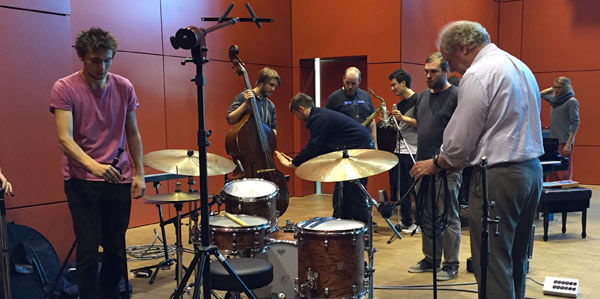Signal Flow First
The demo session in Mainz took place in a relatively reverberant performance space. The jazz quartet was arranged on the raised stage at the front. I described my microphone choices and the placement of the 16 microphones to the student group in yesterday’s post. Once everything was connected to the microphone input box, we all returned to the control room to connect the mics to the preamps and then into the I/O boxes, which contain the analog to digital converters.
There are three stages to making a traditional commercial recording: tracking, overdubbing, and mixing. However, if the production is a classical or jazz ensemble, then the overdubbing step can be omitted…if all of the instruments and voices are captured at the same time. The Mainz session was of this type. The plan was to record the entire ensemble at once. This technique keeps things as simple as possible.
Another important aspect of recording “semi-live” (everyone playing but without an audience) is the avoidance of headphones, which are usually used so that everyone can hear everyone else…and so that the musicians/vocalists can hear themselves! Musicians prefer to hear each other acoustically but the demands of multitracking and conventional production techniques require the isolation afforded by using headphones.
Virtually all microphones need to be brought up from mic level (nominally -60 dB) to line level. Audiophiles debate endlessly about the quality of their DACs, about upsampling, and sample rates. They should be equally interested in the quality of the mic preamplifiers used at the beginning of the production chain. Unfortunately, this information is never recorded as part of the session notes.
Part of the MQA (Mater Quality Authenticated) initiative requires that the type of ADC be known and retained part of the metadata of each analog to digital transfer. This information can then be used to insure that the exact parameters of that unit are used during the reconstruction of the analog waveform.
I’m not convinced that information about the specific mic preamps and ADCs will be widely available and could thus diminish the advancement that MQA promises.
Setting the gain structure for each input microphone is a critically important step in the fidelity of a recording. The level must be set so that the loudest sound produced by the musicians doesn’t eclipse the maximum available “headroom” on the mic pre and the ADC. A whole project can be ruined if the incoming level causes a device to distort. If the level is too low, the potential dynamic range of your recording can be compromised. The engineer either gets it right at this stage or the project suffers from the very first stage.
The output of the analog to digital converters is routed to the individual channels of the Pro Tools recording system. The setup in Mainz was limited to 48 kHz/24-bits but I assured Moritz that it would be fine for our demonstration purposes. The goal of this stage of the process is to maximize the output of the ADC to each of the 16 tracks. One again, you don’t want to exceed the upper limits of the 24-bit encoding system nor do you want to lose any potential fidelity by setting the input level too low.
This was quickly accomplished with all 16 tracks on the PT system. The next step is to successfully set up the 5.1 surround monitoring and create a rough mix in the control room.


I really hope that MQA makes it and becomes widespread. As for the lack of info about the setup used for the recordings, maybe you should appeal to Bob Stuart of Meridian and share your thouths about this. Bob is very keen on the success of MQA and he will consider everything that might hinder this success. But even if Bob will not comply, MQA is good enough to deserve widespread acceptance anyway.
MQA is a very innovative technology but it won’t fundamentally change the nature of high-quality music reproduction. IT may make better recordings streamable.
Some audiophiles do know enough about the recording process to understand these things make a difference, so some audiophile labels include information about the recording equipment used. I’ve even seen liner notes with diagrams of microphone placement. One moderately large label, Bis Records, lists the brands of microphones, the microphone preamp, ADC, monitoring equipment, and original sample rate in the liner notes of each of its recordings. But, you’re right, in the main, this information is not available.